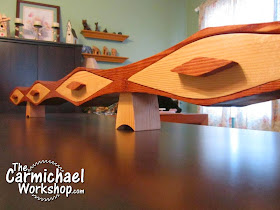Once again, I find myself knee deep into a 2x4 project and facing a deadline for the 2x4 competition hosted by Summers Woodworking. This will be my fourth time entering a 2x4 competition. It's 2x4 Contest Season again!
A 2x4 project is such a fun challenge to face in the workshop. You must adapt to being limited to just one 8-foot 2x4 (which is actually only 1.5” x 3.5”) unless your project is small. You have to plan your cuts well and maximize your lumber so that you have enough material to finish the project. This does not allow much room for error, so it’s a good idea to pick out the best 2x4 you can find, then measure twice (or even three times) before you cut. The challenge to me is to not just make something out of a 2x4, but to make the finished project look like there’s no way it could have started from a
2x4.
Whether you are a hand tool person, power tool person, or both, it helps to have a variety of tools you can use to slice up the 2x4 any way you wish. When I design a project for a 2x4 contest, I purposely try to design it so that there are no pieces that maintain the original 1.5”
x 3.5” dimensions. This helps to disguise the fact that you started with a 2x4. To do this, you will most likely need to rip and resaw the board.
Ripping is commonplace in the shop, but resawing can be intimidating and deserves respect as far as safety is concerned. To resaw on the table saw, I raise the blade to about 1/4 of the height of the board and cut from both sides, flipping the board end-over-end. Then I raise the blade to 1/2 height, and cut from both sides which separates the board. It's a good idea to leave a thin piece of wood attached in the middle for safety and then break them apart. A solid fence and a good push stick are required to keep control of the board!
For my current 2x4 project, I needed to resaw a chunk of 2x4 into 5 thin boards using my bandsaw. The bandsaw has a smaller kerf and removes less material than the table saw. I was surprised at how well my old Craftsman bandsaw did, but I had to go slow. I used a 3 tpi blade to help reduce drift and burning. Larger gullets between the teeth help remove sawdust from the cut. This does require some sanding or a pass through a planer to remove the saw marks.
I think creativity and workmanship are the two most important ingredients in a woodworking contest and they go hand in hand. I believe it takes some level of both to create a good contest entry, especially for a 2x4 contest. It’s not easy to make something out of a 2x4 that doesn’t look like it started with a 2x4, but that’s all part of the fun in the first place.
Also, it can’t hurt to spend time on the presentation of your project. Whether the contest requires a photo, video, article, or other type of
submission, a little extra effort here can make a difference. Good luck to everyone who will be entering a 2x4 contest this season! I can’t wait to show you what I've come up with this year!







No comments:
Post a Comment
Note: Only a member of this blog may post a comment.